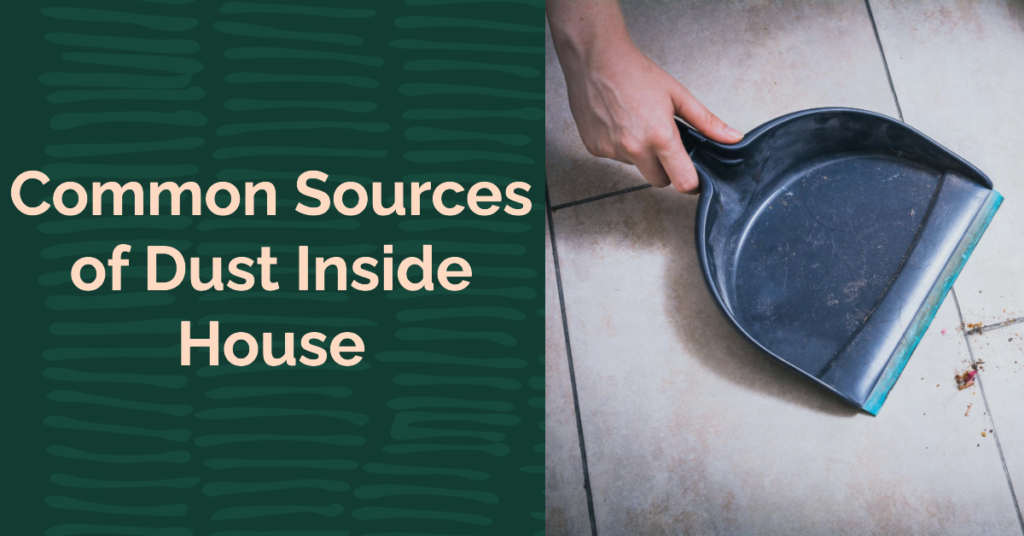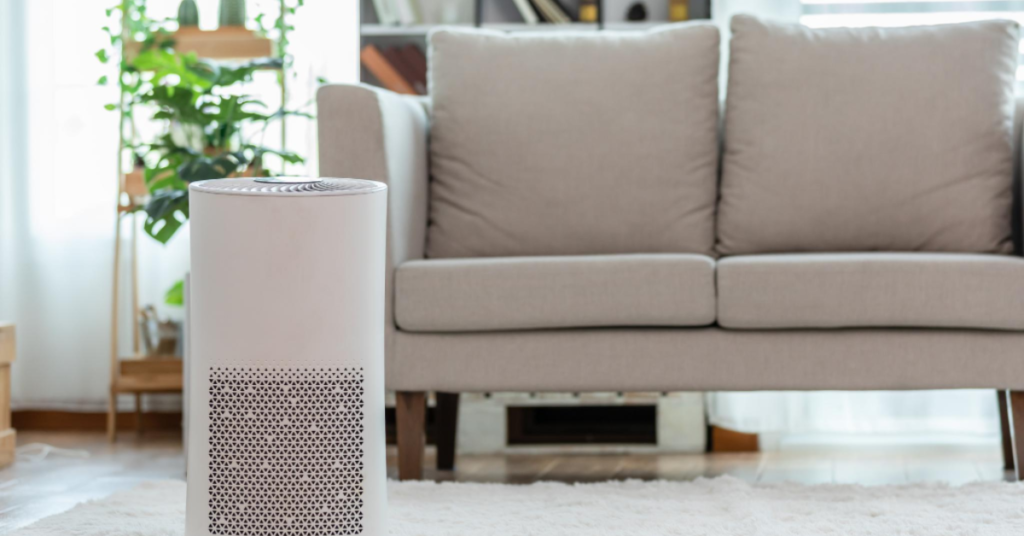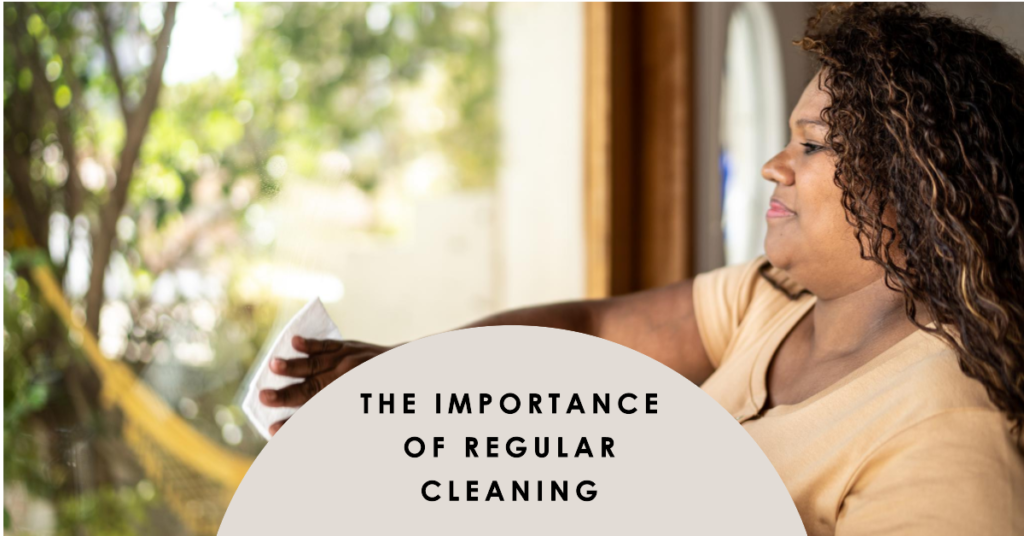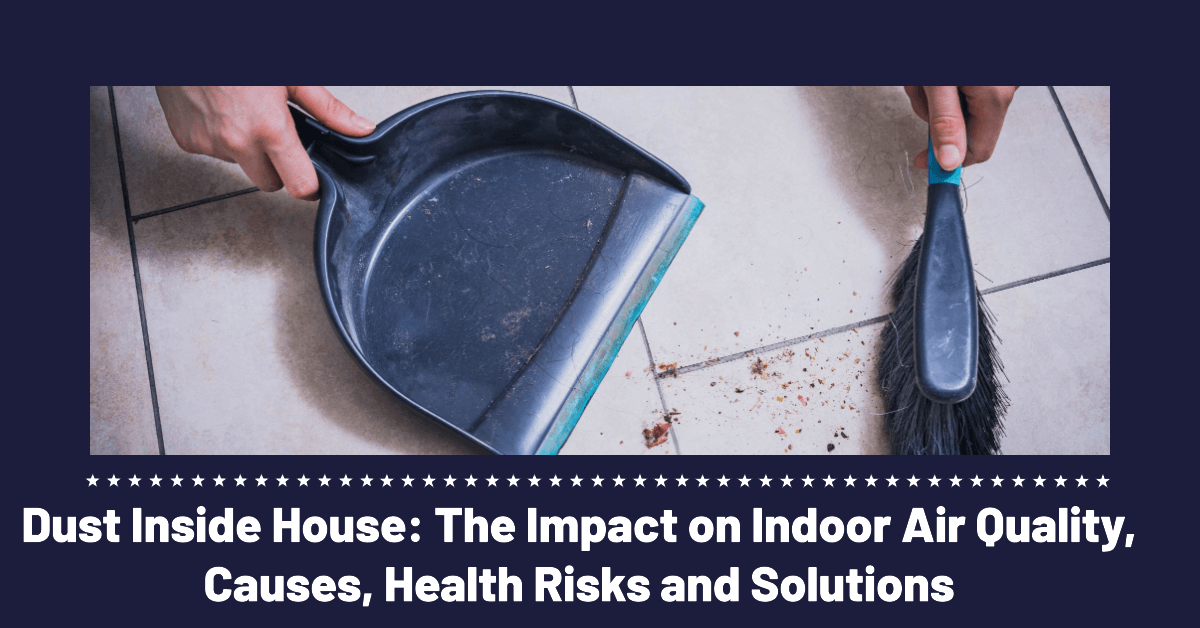Dust Inside House are tiny, seemingly innocuous particles that find their way into every nook and cranny of your home. While it might appear harmless, indoor dust can have a significant impact on quality of indoor air, health and overall well-being. In this article, we’ll start to explore Dust – what it is, where it comes from, and most importantly, how you can tackle it to breathe fresher, cleaner air. So, let’s dust off our knowledge and delve into the importance of addressing dust in our indoor environments.
Dust is an inevitable part of our daily lives, comprising a motley crew of particles such as dead skin cells, soil, pollen and fibers from various sources. It often enters our homes through open windows and doors, hitching a ride on our clothing or settling in from the air. This article aims to shed light on the sources and consequences of indoor dust while providing practical solutions to keep your living spaces free of dust indoor air pollution.
Common Sources of Dust Inside House
Let’s roll up our sleeves and begin by identifying the common culprits behind indoor dust. Dust in home air doesn’t just magically appear; it’s sourced from various origins, both inside and outside our homes. By understanding these sources, you can take proactive steps to reduce dust accumulation, ultimately improving the quality of the air you breathe.

| Source | Description |
|---|---|
| Outdoor Influences | Dust can enter your home through open windows, doors, and on the clothes and shoes of occupants. Regular entry points for outdoor dust. |
| Human Activities | Daily activities like walking, sweeping, and even pet movements can stir up dust settled in the home, making it airborne. |
| Building Materials | Dust particles can originate from construction materials, such as drywall, wood, and insulation, which degrade over time and release particles. |
By recognizing these sources, you’re better equipped to take action against the relentless accumulation of dust. In the sections to come, we’ll delve into the health risks associated with dust indoor air pollution and most importantly, how to tackle these challenges effectively.
Health Risks Associated with Dust in home air
Dust may be ubiquitous, but its effects on our health are far from benign. In fact, Dust Inside House can be a silent saboteur, posing various health risks that can be particularly concerning for allergy sufferers and those with respiratory conditions. In this section, we’ll explore the potential health issues associated with dust indoor air pollution exposure, ranging from bothersome allergies to more serious respiratory concerns.
Respiratory Issues: One of the most common health issues stemming from dust exposure is respiratory problems. Fine dust particles, when inhaled, can irritate the respiratory tract. This irritation may lead to symptoms such as coughing, sneezing, and a runny or stuffy nose. Over time, it can exacerbate existing respiratory conditions, such as asthma or chronic obstructive pulmonary disease (COPD).
Allergies: Dust is a notorious trigger for allergies. The proteins found in dust mites, a microscopic pest often present in indoor dust, can provoke allergic reactions in susceptible individuals. Allergic responses may manifest as skin rashes, itching, or hay fever-like symptoms. For those with dust mite allergies, the bedroom can become a battleground.

Dust Mites and Their Effects: Speaking of dust mites, these tiny arachnids are like the phantom terrorists of the dust world. They feed on our skin flakes, leaving behind allergenic proteins in their droppings. These proteins can be inhaled and trigger allergic reactions. For some, dust mites can make a home an uncomfortable place to be.
Understanding the potential health risks associated with dust inside house is the first step toward making informed decisions to protect yourself and your loved ones. As we journey through this article, we’ll explore strategies for reducing dust and minimizing its impact on your health.
By tackling the origins of dust and acknowledging the health risks it poses, we’re now better equipped to navigate the intricacies of dust control. The following sections will delve into effective cleaning methods, the role of air purifiers, and essential maintenance practices to keep your indoor air fresh and healthy. So, let’s dust off our knowledge and take the first step toward a cleaner, healthier living environment.

Controlling and Reducing Dust
Now that we’ve established the sources and health risks associated with dust inside house, it’s time to roll up our sleeves and dive into the nitty-gritty of dust control. Fortunately, there are a multiple methods and tools at your disposal to help reduce dust in home air and improve your indoor air quality.
| Method | Description |
|---|---|
| Effective Cleaning | Regular dusting and vacuuming with HEPA filters are vital for maintaining clean indoor air. Pay attention to often-overlooked areas like curtains and upholstery. |
| Air Purifiers | High-quality air purifiers can filter out dust particles and allergens, improving indoor air quality. Choose the right size and type based on your space. |
| Maintenance Practices | Regularly changing HVAC filters, sealing gaps and cracks and keeping humidity levels in check contribute to effective dust control. |
By implementing these methods, you’ll be well on your way to maintaining a cleaner and healthier living environment. Now, let’s explore how dust can affect the health of your little ones and what you can do to create a dust-free nursery.

Dust and Children’s Health
Children, with their developing respiratory systems and immune systems, are particularly vulnerable to the adverse effects of indoor dust. Ensuring a dust-free nursery and living environment is crucial for their well-being. Let’s delve into the ways that dust can impact children’s health and the steps you can take to provide them with the cleanest air possible.
Effects on Developing Lungs: Children breathe in more air per unit of body weight than adults, making their developing lungs more susceptible to respiratory issues caused by dust exposure. The fine particles in dust can penetrate deep into their respiratory tract, potentially leading to coughing, wheezing, and other symptoms.
Childhood Allergies: Dust is a known trigger for childhood allergies. Exposure to allergenic particles in dust, like dust mites or pet dander, can lead to allergic reactions such as skin rashes, sneezing, and itchy, watery eyes. Allergies can disrupt a child’s sleep and daily activities, affecting their overall quality of life.
Keeping a Dust-Free Nursery: Designing a dust free nursery for your little one is a proactive step in ensuring their health and comfort. Start by selecting washable curtains, rugs, and bedding, as these can be easily cleaned to remove dust. Use an air purifier with Hepa filter in the nursery to maintain clean air quality. Frequent cleaning with the right tools, as mentioned in the previous section, is essential.
Maintaining a dust-free environment for your children is a gift of health and well-being. As we proceed through this article, we’ll explore the impact of dust on HVAC systems and the broader environment, as well as dive into the importance of regular cleaning and the role of technology in combatting dust
Dust in HVAC Systems
While we often think of dust as something that accumulates on surfaces, it can also infiltrate our HVAC (Heating, Ventilation, and Air Conditioning) systems. This not only affects indoor air quality but also the efficiency and longevity of these systems. In this section, we’ll discuss the impact of dust on HVAC systems and what you can do to mitigate its effects.
| Topic | Description |
|---|---|
| Impact on System Efficiency | Dust accumulation in HVAC systems can reduce their efficiency, leading to higher energy consumption. Regular cleaning and maintenance are essential to prevent this. |
| Duct Cleaning and Maintenance | Routine cleaning of air ducts is crucial in preventing the circulation of dust and contaminants throughout the home. Scheduled maintenance checks can identify issues early. |
| Filtration Solutions | High-efficiency air filters are effective in trapping dust particles. Consider using HEPA filters, which can capture even smaller particles, enhancing indoor air quality. |
Maintaining a clean HVAC system not only ensures better indoor air quality but also prolongs the life of your equipment. It’s a crucial step in your journey to a dust-free and healthy home.
Environmental Impact of Dust
Now that we’ve explored the local and personal effects of indoor dust, let’s zoom out and consider the broader environmental impact of dust, both indoors and outdoors. Dust is not just an inconvenience; it plays a role in global consequences, affecting ecosystems and human activities on a large scale.
Dust in the Great Outdoors: Dust isn’t limited to our indoor environments. It’s a natural part of the outdoor world, originating from sources like soil erosion, volcanic eruptions, and even dust storms. While this outdoor dust may seem unrelated to your indoor air quality, it’s crucial to understand that the air exchange between indoors and outdoors can bring outdoor dust into your living spaces.
Dust as an Air Pollutant: The fine particles in dust can have harmful effects on both the environment and human health. When released into the atmosphere, dust particles can contribute to the formation of particulate matter, a type of air pollution. Particulate matter is associated with respiratory and cardiovascular problems and can even lead to premature death in highly polluted areas.
Global Consequences: The impact of dust extends beyond the immediate environment. Dust storms, such as those in arid regions, can transport vast amounts of dust across continents. This movement of dust has far-reaching consequences, from depositing essential nutrients into ocean ecosystems to influencing climate patterns. Dust is a fascinating and complex part of the Earth’s interconnected systems.
Understanding the broader environmental impact of dust underscores the importance of local dust control efforts. It reminds us that the cleanliness of our indoor environments is not just about personal comfort but also about our interconnectedness with the natural world. In the next section, we’ll delve into the practical aspects of regular cleaning to keep your home dust-free.

The Importance of Regular Cleaning
Effective cleaning is your frontline defense against dust. By adopting the right cleaning techniques and routines, you can significantly reduce dust buildup in your home and enjoy improved indoor air quality. In this section, we’ll explore the importance of regular cleaning and provide insights into best practices.
Dusting Techniques: Dusting is an art, and the tools you choose can make a significant difference. Opt for microfiber cloths or electrostatic dusters, as they trap and hold dust particles effectively. Dust from top to bottom, starting with higher surfaces like shelves and ceiling fans, and work your way down to the floors. Don’t forget to dust behind and underneath furniture.
Vacuuming Methods: A vacuum cleaner with a HEPA filter is your best friend in the fight against dust. Vacuum all carpeted areas, rugs, and upholstered furniture regularly. Pay extra attention to high-traffic areas and places where pets frequent. Vacuuming not only removes dust but also prevents it from being stirred back into the air.
Safely Disposing of Dust: When you’re done with your cleaning, it’s essential to dispose of the collected dust correctly. Empty your vacuum cleaner’s dustbin or replace vacuum bags outside your home to prevent dust from re-entering your living spaces. Consider wearing a mask if you’re particularly sensitive to dust while emptying the vacuum.
By following these cleaning practices, you can maintain a cleaner and healthier home. But what if you could leverage technology to make your life even easier and keep dust at bay? In the next section, we’ll explore the role of smart home devices and air quality monitoring in your quest for a dust-free living environment.
Using Technology to Combat Dust
In today’s digital age, technology offers innovative solutions for many aspects of our lives, including controlling indoor dust. Smart home devices and air quality monitoring tools are becoming increasingly popular in the battle against dust. In this section, we’ll delve into how technology can help you maintain a dust-free and healthy indoor environment.
| Topic | Description |
|---|---|
| The Role of Smart Devices | Smart home devices, like robotic vacuum cleaners and air purifiers, offer automated solutions to keep dust at bay. They can be controlled remotely for convenience. |
| Air Quality Monitoring | Use air quality monitors to track dust levels and other pollutants in real-time. This data helps in adjusting cleaning schedules and identifying problem areas. |
| Automated Cleaning Solutions | Robotic vacuums and cleaning robots use sensors and AI to navigate and clean your home. They offer a hands-free approach to dust control. |
Leveraging technology in your battle against dust not only makes the process more convenient but also more effective. As we move forward, we’ll explore the importance of maintaining dust control in the workplace to ensure the health and well-being of employees.
Workplace Dust Control
Dust control is not limited to our homes. It’s equally crucial in workplace environments. Whether it’s an office, a factory, or any other professional setting, addressing dust in the workplace is essential for employee health and safety. In this section, we’ll delve into the occupational hazards of dust and how to control them effectively.
Occupational Hazards: Depending on the nature of the work, employees may be exposed to various types of dust, including but not limited to wood dust, metal dust, and silica dust. Prolonged exposure to these substances can lead to serious health issues, including respiratory problems and occupational diseases. Ensuring workplace safety includes minimizing dust exposure.
Dust Control in Industrial Settings: In industrial or manufacturing settings, dust can be a significant concern. Machinery, cutting, and grinding processes can generate substantial amounts of dust particles. Implementing dust control measures, such as local exhaust ventilation systems, dust collectors, and employee protective equipment, is crucial. These measures not only protect the health of workers but also improve overall workplace safety.
Protecting Workers’ Health: Employee health is a top priority for any responsible employer. In addition to implementing dust control measures, providing proper training on the risks of dust exposure and the use of personal protective equipment (PPE) is essential. Employers should also conduct regular air quality assessments to ensure that dust levels are within safe limits.
By addressing dust hazards in the workplace, employers create a safer and healthier environment for their employees. This leads to increased job satisfaction, better health, and improved overall productivity. In the next section, we’ll look to the future of dust mitigation, including innovations and sustainable solutions.
The Future of Dust Mitigation
The battle against dust in home air is ongoing, and as technology and research progress, so do our dust mitigation strategies. In this section, we’ll explore the future of dust control, focusing on innovations, research developments, and sustainable solutions that promise a cleaner and healthier future.
Innovations in Dust Control: Researchers and innovators are continually developing new technologies and techniques for controlling dust. These innovations may include advanced air filtration systems, more efficient air purifiers, and even materials with dust-repelling properties. As these innovations become more accessible, they will significantly contribute to dust reduction efforts.
Research and Developments: Scientific research plays a crucial role in our understanding of dust and its effects. Ongoing studies help us comprehend the specific health risks associated with different types of dust and refine our control methods. Future research may uncover new insights into the dynamics of dust in indoor environments, leading to more effective mitigation strategies.
Sustainable Solutions: As environmental awareness grows, so does the demand for sustainable dust control solutions. This includes eco-friendly cleaning products, energy-efficient air purifiers, and sustainable building materials. Embracing these solutions not only improves indoor air quality but also reduces our environmental footprint.
By looking to the future, we can remain optimistic about our ability to control and mitigate indoor dust effectively. Innovations, research, and sustainable practices will lead the way toward cleaner and healthier living spaces.
Addressing Dust in Specific Environments
Dust control is not a one-size-fits-all solution. Different environments have unique considerations when it comes to managing dust. In this section, we’ll explore how to address dust in specific settings, including schools, healthcare facilities, and cleanrooms and laboratories.
Dust Control in Schools: Schools are environments where the health and well-being of students are of utmost importance. Effective dust control in schools includes regular cleaning routines, the use of air purifiers, and proper maintenance of HVAC systems. Schools should also educate students and staff about the importance of maintaining a clean and dust-free environment.
Healthcare Settings: Hospitals and healthcare facilities require a higher level of hygiene and air quality. The presence of airborne dust can be particularly concerning, as it can carry pathogens. Advanced air filtration systems and rigorous cleaning practices are essential. Healthcare institutions should follow strict protocols to minimize dust in critical areas like operating rooms and patient wards.
Cleanrooms and Laboratories: Environments with precision equipment, such as cleanrooms and laboratories, are highly sensitive to dust. Even minuscule particles can affect experiments and production processes. These environments require specialized HVAC systems, stringent cleanroom protocols, and staff training to maintain the utmost cleanliness.
Addressing dust in these specific environments is critical for the well-being of occupants and the success of activities conducted in these spaces. As we focus on specialized environments, the next section discusses keeping electronic devices dust-free.
Keeping Electronic Devices Dust Free
Electronic devices, from smartphones to computers, are essential in our daily lives. However, they are also dust magnets and dust accumulation can affect their performance. In this section, we’ll explore the relationship between dust and electronics and provide tips for keeping your gadgets dust-free.
Dust and Electronics: Dust can infiltrate electronic devices, affecting their functionality and longevity. Dust can clog vents, impair cooling systems, and cause overheating. It can also accumulate on screens and keyboards, diminishing the user experience.
Cleaning Gadgets and Devices: Regularly cleaning your electronic devices is essential. Use microfiber cloths or specialized screen-cleaning solutions to wipe away dust and smudges from screens. Compressed air can help remove dust from keyboards and hard-to-reach crevices. Be gentle but thorough in your cleaning.
Dust-Resistant Technology: Some manufacturers design electronic devices with dust-resistant features. These can include sealed cases, dust-resistant keyboards, and cooling systems that prevent dust infiltration. When purchasing new gadgets, consider those with these features to reduce dust-related issues.
By keeping your electronic devices dust-free, you not only extend their lifespan but also ensure that they function optimally. In our final sections, we’ll explore personal hygiene practices that contribute to dust reduction and conclude our journey through the impact of dust on indoor air quality.
Personal Hygiene and Dust Reduction
In our quest to combat dust effectively, personal hygiene plays a crucial role. While it might not be immediately evident, our daily habits, such as showering, clothing choices, and overall cleanliness, can significantly influence the dust levels in our living spaces. In this section, we’ll explore how personal hygiene practices contribute to dust reduction.
Showering and Clothing: Dust is not solely an external invader; our bodies shed dead skin cells, which can contribute to dust buildup. By showering regularly and changing into clean clothes, we can reduce the introduction of these particles into our living spaces. Additionally, using freshly laundered bedding and towels can help minimize dust in bedrooms and bathrooms.
Reducing Personal Dust Contribution: Dust isn’t just an issue of the environment; we are all contributors. Consider factors like personal grooming, pets, and activities that can generate dust. By being mindful of our actions and minimizing behaviors that increase dust, we collectively contribute to a cleaner indoor environment.
Indoor Clothing and Shoes: Consider designating indoor clothing and footwear to prevent outdoor dust and contaminants from being tracked inside. Creating a specific area near the entrance of your home for shoe removal can also significantly reduce the amount of outdoor dust that enters.
By paying attention to personal hygiene and adopting these practices, we can reduce the overall dust levels in our living spaces, creating a cleaner and healthier environment for ourselves and our loved ones.
Conclusion
In our exploration of “Dust Inside House: The Impact on Indoor Air Quality, Causes, Health Risks, and Solutions” we’ve uncovered the various sources of dust inside house, its health risks, and effective methods for mitigating it. Dust is an omnipresent adversary, but with knowledge and commitment, we can maintain cleaner and healthier indoor environments.
From understanding the sources of indoor dust to the role of technology in dust control, we’ve highlighted the importance of consistent cleaning and maintenance practices. We’ve also delved into the significance of managing dust in specific environments, including workplaces, healthcare settings, and cleanrooms. Keeping electronic devices dust-free and paying attention to personal hygiene practices further contribute to our efforts.
By taking proactive measures, using innovative technology, and embracing sustainable solutions, we pave the way for a future with reduced dust inside house and improved air quality. This not only benefits our physical health but also enhances our overall well-being, productivity, and quality of life.
In closing, remember that the battle against dust indoor air pollution is ongoing. It’s a journey toward creating spaces that promote health, comfort, and vitality. By working together, staying informed, and implementing the strategies discussed, we can all breathe easier in environments with cleaner and fresher air.
FAQ
Why is my house so dusty inside?
Your house can become dusty due to various reasons. Common factors include outdoor dust entering through windows and doors, shedding of skin cells and pet dander, dust mites, poor ventilation, and the circulation of dust from heating and cooling systems. Regular cleaning and proper filtration can help mitigate indoor dust.
Where does dust come from in a closed house?
Even in a closed house, dust can accumulate from a variety of sources. This includes outdoor dust carried in on clothing and shoes, shedding of skin cells and pet fur, dust mites in bedding and upholstery, and particles from cooking and cleaning. Dust can also be stirred up from indoor surfaces and recirculated through HVAC systems.
How do you get rid of indoor dust?
To reduce indoor dust, consider these steps:Vacuum and dust regularly using a HEPA filter vacuum cleaner.
Wash bedding, curtains, and upholstery frequently.
Use air purifiers with HEPA filters.
Keep windows and doors closed on high-dust days.
Maintain proper humidity levels to control dust mites.
Seal gaps and cracks in doors and windows.
Upgrade HVAC filters and change them regularly.
Minimize clutter, which can trap dust.
Consider hard flooring instead of carpets.
Use doormats to trap outdoor dust before it enters your home.
How can I stop my house from being so dusty?
To reduce dust in your house, you can:Vacuum and dust regularly.
Use doormats at entrances to trap outdoor dust.
Upgrade HVAC filters and change them regularly.
Keep windows and doors closed on high-dust days.
Maintain proper humidity levels to control dust mites.
Seal gaps and cracks in doors and windows.
Consider hard flooring instead of carpets.
Use air purifiers with HEPA filters.
Do air purifiers get rid of dust?
Yes, air purifiers with HEPA filters can effectively capture and remove dust particles from the air, helping to reduce indoor dust levels. They are particularly useful for people with allergies or respiratory issues.
Is it better to dust with a wet or dry cloth?
It’s generally better to dust with a damp or microfiber cloth rather than a dry one. A damp cloth traps and holds dust particles, preventing them from becoming airborne and settling elsewhere.
Should you dust or vacuum first?
It’s usually more efficient to dust before vacuuming. Dusting can dislodge particles from surfaces, which can then be removed by vacuuming. This sequence helps ensure that you capture as much dust as possible.
DheerajSonwane is a dedicated writer with expertise in air purification technologies. He focuses on providing well-researched content to help readers improve indoor air quality in homes and businesses. As the lead writer at AirPurifierMaster.com, Dheeraj offers practical advice his insightful reviews guide individuals in choosing the best air purifiers for their needs.


3 thoughts on “Dust Inside House: The Impact on Indoor Air Quality, Causes, Health Risks and Solutions”